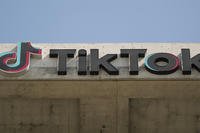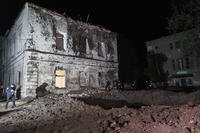WASHINGTON — The White House said on Friday that North Korea has delivered more than 1,000 containers of military equipment and munitions to Russia for its ongoing war in Ukraine.
Speculation about a possible North Korean plan to refill Russia’s munition stores drained in its protracted war with Ukraine flared last month, when North Korean leader Kim Jong Un traveled to Russia to meet President Vladimir Putin and visit key military sites.
White House National Security Council spokesman John Kirby said that the U.S. believes Kim is seeking sophisticated Russian weapons technologies in return for the munitions to boost North Korea's military and nuclear program.
The White House released images that it said show the containers were loaded onto a Russian-flagged ship before being moved via train to southwestern Russia. The containers were shipped between Sept. 7 and Oct. 1 between Najin, North Korea, and Dunay, Russia, according to the White House.
"We condemn the DPRK for providing Russian with this military equipment, which will be used to attack Ukrainian cities and kill Ukrainian civilians and further Russia’s illegitimate war," Kirby said, using the initials for Democratic People's Republic of Korea, the country's official name. “In return for support, we assess the Pyongyang is seeking military assistance from Russia including fighter aircraft, surface to air missiles, armored vehicles, ballistic missile production equipment, or other materials and other advanced technologies.”
The U.S. unveiled the intelligence determination as North Korea lashed out Friday at the arrival of a U.S. aircraft carrier battle group in South Korea, calling it a provocation and again raising the specter of using nuclear weapons to defend itself.
The North’s official Korean Central News Agency called the aircraft carrier’s arrival “an undisguised military provocation” that proves a U.S. plan to attack North Korea is being realized. It threatened to respond in line with its escalatory nuclear doctrine that authorizes the preemptive use of nuclear weapons.
The U.S. has accused North Korea of previously providing ammunition, artillery shells and rockets to Russia. North Korea has previously denied providing weaponry to Moscow.
The Center for Strategic and International Studies, a Washington think tank, last week published satellite photos that showed a sharp increase in rail traffic along the North Korea-Russia border,
The report said satellite images as of Oct. 5 captured “a dramatic and unprecedented level of freight railcar traffic” at the Tumangang Rail Facility. It said images show approximately 73 railcars while a review of previous satellite images over the past five years shows about 20 railcars at this facility at most.
Kim last month, after he had met with Putin, called for an exponential increase in production of nuclear weapons and for his country to play a larger role in a coalition of nations confronting the United States in a “new Cold War,” North Korean state media said.
During Kim’s six-day trip to Russia, his longest foreign travel as a leader, the two countries said they discussed boosting their defense ties but didn’t disclose any specific steps. Foreign experts speculate the two countries, both locked in confrontations with the West, were pushing to reach arms transfer deals in violation of U.N. Security Council resolutions.
The trip to Russia was also Kim's first foreign trip since the pandemic, during which North Korea imposed tight border controls for more than three years. After decades of hot-and-cold relations, Russia and North Korea have drawn closer since Moscow’s invasion of Ukraine in 2022.
Relations between Moscow and Pyongyang go back to the 1948 foundation of North Korea, as Soviet officials installed young, ambitious nationalist Kim Il Sung, the late grandfather of Kim Jong Un, as the country’s first ruler. Since then, Soviet aid shipments had been crucial in keeping North Korea’s economy afloat for decades before the disintegration of the Soviet Union in the early 1990s.
Meanwhile, U.S. Secretary of State Antony Blinken, who is in the Middle East to consult with allies in the aftermath of last week's Hamas attack on Israel, spoke by phone on Friday with Ukrainian Foreign Minister Dmytro Kuleba.
Blinken and Kuleba discussed the latest battlefield developments, according to the State Department.











